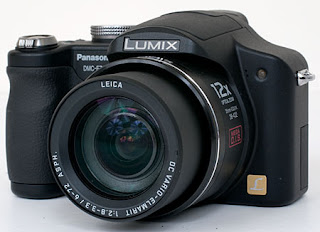The Panasonic Lumix DMC-FZ8 ($350) is the updated version of the popular DMC-FZ7 ultra zoom from last year (see our review). This latest model is an evolutionary upgrade, providing these new features compared to the FZ7:
- A 7.2 effective Megapixel CCD (versus 6MP on the FZ7)
- Uses Venus III image processor (the FZ7 used Venus II)
- Higher resolution LCD and electronic viewfinder (the latter is a bit larger as well)
- RAW image format supported
- 11-point autofocus system (versus 9-point)
- "Two speed" zoom controller
- ISO now goes up to 1250 in regular shooting modes, or 3200 in high sensitivity mode
- Intelligent ISO mode automatically adjusts ISO based on lighting and subject moving
- Support for SDHC memory card format
- Battery life improved by almost 20%
I don't think anyone's going to complain about those new features, except for maybe the Venus III Engine, which has a rather overzealous noise reduction system (to say the least).
The other features are on the FZ8 are the same as before. You get a great 12X Leica zoom lens, optical image stabilization, a 2.5" LCD display, full manual controls, a widescreen movie mode, and more.
The DMC-FZ7 was one of my favorite ultra zoom cameras of 2006. Does the FZ8 fair just as well in 2007? Find out now in our review!
What's in the Box?
The DMC-FZ8 has an average bundle. Inside the box, you'll find:
- The 7.2 effective Megapixel Lumix DMC-FZ8 camera
- CGR-S006 lithium-ion rechargeable battery
- Battery charger
- Lens cap w/retaining strap
- Lens hood w/adapter
- Shoulder strap
- USB cable
- A/V cable
- CD-ROM featuring Lumix Simple Viewer, PhotoFunStudio, SilkyPix Developer Studio, ArcSoft Photo Suite, and drivers
- 145 page camera manual (printed)
While Panasonic bundled a memory card with the DMC-FZ7, here on the FZ8 they chose the built-in memory route. The camera has 27MB of hard-wired memory, which holds one RAW or seven JPEG images, which ain't much. Thus, you'll want to buy a memory card right away (unless you already have one, of course), and I recommend picking up a high speed 1GB card if I were you. The camera supports SD, MMC, and the new high capacity SDHC memory card formats. If you do get an SDHC card, you might want to pick up one with a "Class 4" rating for best camera performance.
While the DMC-FZ8 uses the same battery as its predecessor, Panasonic has managed to squeeze nearly 20% more battery life out of it, mostly due to the more efficient Venus III engine. The CGA-S006 battery packs 5.1 Wh of energy, which is moderate. Here are the battery life numbers for the FZ8 and its competitors:
| Camera | Battery life, LCD on (CIPA standard) | Battery used |
| Canon PowerShot S5 IS * | 450 shots | 4 x 2500 mAh NiMH |
| Fuji FinePix S700 | 500 shots | 4 x 2500 mAh NiMH |
| Fuji FinePix S6000fd | 400 shots | 4 x 2500 mAh NiMH |
| GE X1 * | 600 shots | 4 x 2500 mAh NiMH |
| Kodak EasyShare Z712 IS * | 275 shots | KLIC-8000 |
| Nikon Coolpix S10 * | 300 shots | EN-EL5 |
| Olympus SP-550 Ultra Zoom * | 530 shots | 4 x 2300 mAh NiMH |
| Panasonic Lumix DMC-FZ7 * | 320 shots | CGR-S006 |
| Panasonic Lumix DMC-FZ8 * | 380 shots | CGR-S006 |
| Panasonic Lumix DMC-FZ50 * | 360 shots | CGR-S006 |
| Panasonic Lumix DMC-TZ3 * | 270 shots | CGA-S007 |
| Sony Cyber-shot DSC-H7 * | 300 shots | NP-BG1 |
the product from :dcresource.com
